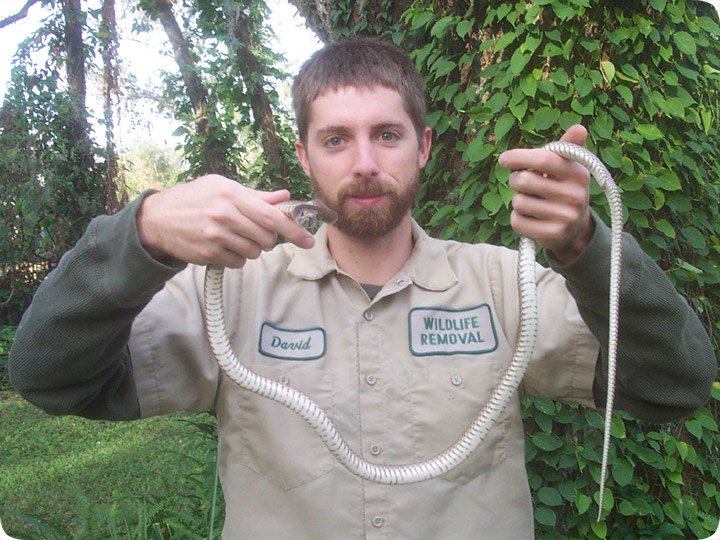-
info@aaanimalcontrol.com
Call us for help in your town
Humane Wildlife Education
Eastern Coachwhip Snake

12.06.2004 - Sweet! My first Eastern Coachwhip! I've been reading about this snake, and always wanted to catch, or even see, one. Today I finally got my chance. A customer called about a snake terrorizing his lawn, and now hiding under
a large piece of plywood. I arrived at the house, and upon lifting said plywood, out shot this snake like a lightning bolt! The Coachwhip is the fastest snake in North America! But it's not faster than me. I pounced with my super duper lightning
mongoose speed, and captured the hapless serpent. It struck a few times, but I was wearing thick gloves. I was gentle with the snake and bagged it, and took the above photo before relocating it.
The Eastern Coachwhip, (Masticophis flagellum flagellum) is a non-venomous snake. It's thin, and can grow to eight feet long! It has large and distinct scales. It's
a fairly rare snake in the Orlando area. Perhaps they were hunted down and killed, based on the myth that they'd roll into a hoop, chase down people, and whip them to death with
their tails. Of course, I have a suspicion that habitat destruction is a more relevant factor.
Do it yourself: Visit my How To Get Rid of Snakes page for tips and advice.
Get professional help: Visit my Nationwide Pro Directory of wildlife removal experts.
For more wildlife stories, click my Wildlife Blog
or click my below banner to hire a local trapper.
Coachwhip snakes striking - The coachwhip snake is a small species of snake capable of very fast movements. There are a lot of myths surrounding this animal, many originating from the speed of the animal. One such myth involves the coachwhip snake striking out or chasing down a person that threatens it. This is not typical behavior for this animal. Like most snakes, the coach whip is shy around people. It's impressive speed creates an illusion of aggression if the snake moves toward the person in an effort to escape. Another popular myth claims that these serpents will chase a person down, somehow overpower the victim, strangle them, and then make sure the victim is dead by placing their tail up the person's nose. While this is a terrifying story, the coach whip is much too small to overpower a human of any size. These animals eat rodents, lizards, and other small animals. They tend to appear like they want to strike, but this quick, agitated movement is only an attempt to scare off predators. If you have been bitten, the wound is usually mild and does not require treatment.
This is a snake mostly found in the northern parts of the United States. The scientific name of this snake is Masticophis flagellum and it is also known as the whip snake. They are nonpoisonous. Not only that but they are from the family of Colubridae. This family of snakes is quite well-known since its snakes are not limited to one geographical area but are instead spread all over the world. It is extremely huge i.e. an average Eastern Coachwhip snake is 50-70 inches in length which is equivalent to 120-180 cm approximately, whereas the largest snake of this specie is recorded to be 102 inches. They have a distinct color which makes it easier to recognize them. Their head is usually black but then fades to lighter shades of tan or white as you move towards the tail. The younger snakes are tan all over with a few tan and white patterns that are irregular on its body. The name whip snake comes from the patterns on their bodies which reminisce to that of a whip. These snakes have very slender bodies and large eyes which enhances their vision. Coachwhip snakes are very particular regarding their habitat; they prefer spacious areas along with sandy soils. Habitats that fit this description are listed below:
- Old fields
- Spacious pine forests
- Prairies
- Agricultural areas
- Coastal dunes
- Sand hills
Coachwhip snakes are excellent hunters and keep their heads above the ground when going after their prey. Once they catch sight of their prey, they actively pursue it until they make it their next meal. It does not have a limited variety of prey, thus, it consumes an array of animals such as:
- Insects
- Other snakes
- Amphibians
- Birds
- Lizards
- Rodents




















